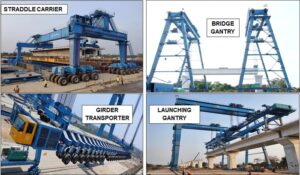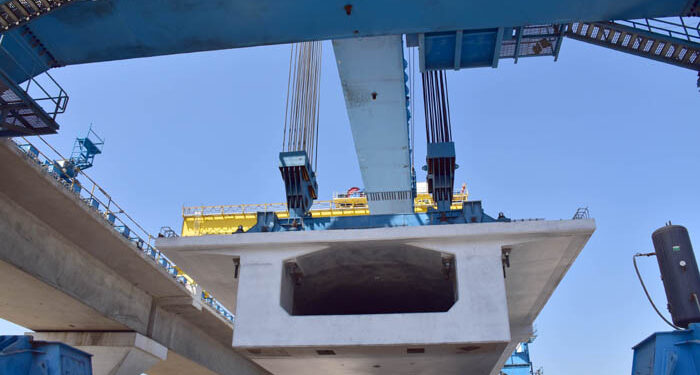ANAND (GUJARAT), FEB 21
The much expected major infrastructure – India’s first Bullet train project – between the two financial hubs Mumbai and Ahmedabad is being constructed at a whopping cost of Rs 1.08 lakh crore by the National High Speed Rail Corridor Limited (NHSRCL) will be completed latest by August 2026. The original deadline was December 2023, the officials said.
Courtesy: NHSRCL
Official sources said that as on January 31, this year the overall physical progress is 25.63%. Overall project works in Gujarat side completed is 32.05 per cent and civil works is 53.47 per cent. In Maharashtra side the overall work completed is 13.37 %.
Pile work completed for 242.18 km and Pier work finished for 140.68 km. Pre-Stressed Box Girders were launched for 30.24 km and the first river bridge over Par River for a length of 320 meters has also been completed.
- The full span pre-stressed box girders were launched using the Larson & Toubro’s heavy duty Straddle carrier with the carrying capacity of 1,100 MTs, which was indigenously manufactured in Tamil Nadu
- The undersea tunnel proposed for the Mumbai-Ahmedabad Bullet Train will ensure conservation of approximately 12 hectares of mangrove forests and the protection of Flamingo Sanctuary in the Thane Creek.
- Based on the same technology as the Shinkansen — the Japanese bullet train — but modified to suit Indian conditions, the Mumbai-Ahmedabad train will run at 320 km per hour and cover a distance of 508 km in three hours.
In an interaction with senior journalists from Tamil Nadu, the Chief Project Manager of the Casting Yard at Gamdi village of Anand district in Gujarat, Pradeep Ahirker and Additional General Manager/ Public Relations, Sushma Gaur said that the Girders for chainage 47 to 446 planned to be cast at this yard.
As many as 734 girders with the length of 49 metre weighing around 970 MT are planned to be casted this yard. Till February 147 Full Span Pre-Stressed Box Girders were produced here.
Kancheepuram plant of Larsen and Toubro in Tamil Nadu manufactures heavy duty Straddle carrier

The full span pre-stressed box girders were launched using the Larson & Toubro’s heavy duty Straddle carrier with the carrying capacity of 1,100 MTs. This equipment has been indigenously developed at the Kancheepuram plant of Larsen and Toubro (L&T) in Tamil Nadu.
“The equipment, which will expedite the construction, has been designed using a state-of-the-art finite element analysis software and has met stringent international codes. The machines were also checked for various critical loading cases and were optimised using combinations of different material grades to ensure long and efficient operation, at a minimum operating cost. There are several challenges to build at such speed and scale, but we are committed to take on this mammoth challenge to deliver India’s first high speed rail project in time and with quality,” said an official.
Also Read:
The Gigantic box for full span pre-stressed box girders has been designed and produced from an engineering firm in Surat. MSMEs and SMEs surrounding areas in the cast yard have explored the opportunity to produce small parts for the project, Pradeep added.
The 64-acre land required for the cast yard was taken from the local formers for lease will be handed over to them as crop cultivable condition after completion of the project, he added.
30 per cent of the project completed
Official sources said that the actual construction of the project has been completed 30 percent till January 31, 2023.
Prime Minister Narendra Modi laid the foundation stone along with the former Japanese Prime Minister Shinzo Abe on September 14, 2017.
Railway Minister Ashwini Vaishnaw and the Japanese officials are rigorously monitoring the progress and taking stock of the project.
Underground tunnel for 21 km, which includes 7 km undersea tunnel
Meanwhile, the National High Speed Rail Corporation Limited (NHSRCL) on February 9 opened technical bids for the 21-km underground tunnel from Kalyan Shilphata to Bandra Kurla Complex (BKC) of the Mumbai-Ahmedabad High Speed Rail Corridor.
As part of this package two of the project, a 7-km stretch of the 21 km tunnel will be built under the sea at Thane Creek, the first undersea tunnel of the country, official sources said.
The 21-km stretch will be a single-tube tunnel will accommodate twin tracks. The section will include constructing 39 equipment rooms at 37 locations adjoining the tunnel.
Tunnel boring machine with a cutter head of 13.1-metre diameter will be used for construction. Usually, 5-6-metre diameter cutter heads are used for urban tunnels used in Mass Rapid Transit Systems (MRTS) or Metros.
An official statement said three TBMs would be used to make about 16 km of the tunnel, and the remaining 5 km will be through the new Austrian tunnelling method (NATM). Both these technologies were used in Mumbai’s underground Metro Line 3 project, on the route from Colaba to SEEPZ via Bandra.
The undersea tunnel has been planned to conserve 12 hectares of mangroves in Thane creek
With more than 75,000 Lesser Flamingos and 50,000 of their greater cousins, there is a bloom of pink in Thane Creek Flamingo Sanctuary. Here is a visual treat from Navi Mumbai. @MangroveForest @MahaForest @NaviMumbaiCity #Mumbai pic.twitter.com/OMSVnT7PSR
— Bombay Natural History Society (@BNHSIndia) May 12, 2022
The undersea tunnel proposed for the Mumbai-Ahmedabad Bullet Train will ensure conservation of approximately 12 hectares of mangrove forests and the protection of Flamingo Sanctuary in the Thane Creek.
This tunnel will be about 25-65 metres deep from the ground level, and the deepest construction point will be 114 metres below Parsik hill near Shilphata.
Railway Minister Ashwin Vaishnav, a graduate of IIT ( Kanpur) explaining the Technical details on the progress of the Bullet Train Project pic.twitter.com/VtL3yzPRU7
— ANIL KUMAR MITTAL (@ANILKUM05405587) February 20, 2023
Meanwhile, addressing at the 7th edition of The Economic Times Global Business Summit 2023 on Day 2, 18 February 2023, the Minister of Railways, Communications and Electronics & Information Technology Ashwini Vaishnaw said “Recently Japanese people came from the Japanese Prime Minister’s Office, and they were surprised at the pace and quality of the work on the Bullet Train project, and some of the innovations that we have done in this construction project decided to design and develop our system out here which has to be simple but should match the current European system”.
Jaoan’s Shinkansen technology
‘s bullet trains
are about to get even faster, safer and more comfortable with the Alfa-X, a new generation model capable of carrying passengers at 360 km/h. Find out more: https://t.co/K32FFrE85i #shinkansen #technology pic.twitter.com/o6W2paudLk
— The Gov’t of Japan (@JapanGov) November 23, 2018
Based on the same technology as the Shinkansen — the Japanese bullet train — but modified to suit Indian conditions, the Mumbai-Ahmedabad train will run at 320 km per hour and cover a distance of 508 km in three hours.
The largest stretch of the corridor — 348 km — is in Gujarat, while 156 km falls in Maharashtra and 4 km in Dadra and Nagar Haveli.
Bullet train project at a glance
508.17 km of rail track between Mumbai and Ahmedabad, 21 km underground.
A maximum speed of 350 km per hour, covering the 508-km stretch in three hours.
Japan giving a loan of Rs 88,000 crore to India for the project at a minimal interest of 0.1%.
Eighty per cent of the funding for the project is through a soft loan from the Japanese government’s Japan International Cooperation Agency (JICA), with the remaining cost. being shared by the Union government and the Gujarat and Maharashtra governments in a 50:25:25 ratio.
The mega project is likely to be completed by 2026.
Number of stations: 12
Maharashtra: 4 stations
Gujarat: 8 stations
Stations in Maharashtra: Mumbai (BKC), Thane, Virar and Boisar
Stations in Gujarat: Vapi, Bilimora, Surat, Bharuch, Vadodara, Anand/Nadiad, Ahmedabad and Sabarmati
Number of depots: 3
Maharashtra: 1 (Thane)
Gujarat: 2 (Surat & Sabarmati)
Operational Control Centre: Sabarmati
The 21 km tunnel will be built between Mumbai’s Bandra Kurla Complex (BKC) station and Kalyan Shilphata, in Maharashtra.
(The Press Information Bureau has arranged the Tamil Nadu media visit of Gujarat)












